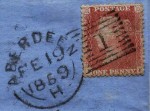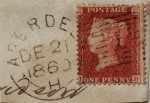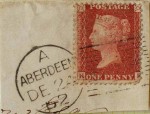Aberdeen’s Experimental Postmarks lasted from January 1856 until May 1865 (the longest period of any of the Scottish Experimentals) with there being five different types, all of which were shown in the Proof Books.
Type 1 State 1
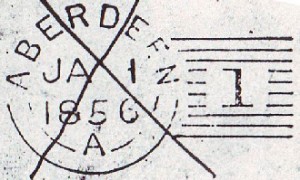 Characteristics: Four short bars either side of ‘1’. The bottom part of the third ‘E’ appears damaged and this is constant on all examples I have seen for this State 1 and also for State 2.
Characteristics: Four short bars either side of ‘1’. The bottom part of the third ‘E’ appears damaged and this is constant on all examples I have seen for this State 1 and also for State 2.
Proofed: 1st January 1856
EKD: 4th January 1856
LKD: 2nd April 1856 (I do have a problem with this as it conflicts with the EKD of Type 1 State 2 but perhaps it is just heavily inked)
Months of Use:
![]()
Known Codes:
![]()
Scarcity Rating: E (Scarce) in view of relatively short life of this State
Picture Gallery
Type 1 State 2
 Characteristics: The same as State 1 except that some time in March/April 1856 damage occurred to the first ‘E’ in Aberdeen. This was constant throughout the life of this State . However, rather surprisingly, the damage to the third ‘E’ mentioned in State 1 appears to be complete in examples I have seen during July 1856, July and December 1857. A printing anomaly?
Characteristics: The same as State 1 except that some time in March/April 1856 damage occurred to the first ‘E’ in Aberdeen. This was constant throughout the life of this State . However, rather surprisingly, the damage to the third ‘E’ mentioned in State 1 appears to be complete in examples I have seen during July 1856, July and December 1857. A printing anomaly?
Proofed: N/A
EKD: 19th March 1856 (but see comments above re Type 1 State 1 LKD)
LKD: 3rd March 1859
Months of Use:

Known Codes:

Notes: a) The lone ‘C’ could well be an under inked ‘G’. Up until August 1856 ‘G’ did not appear to have a horizontal serif albeit there was a definite vertical line. Thereafter it did. See:
b) The ‘H’ code is definite and was the penultimate dated example (19th February 1859)
c) It is unusual to have a number Code but I feel confident there is a ‘sideways 7’. See image.
Scarcity Rating: C (Average), one of the more common Scottish Experimentals.
Picture Gallery
Type 2
 Characteristics: Very similar to Type 1 except that a) the letters are slightly larger in this Type 2 (especially the letters ‘D’ and ‘E’ ), b) the left vertical stroke of ‘N’ points to bar 4 rather than bar 3 as is the case in Type 1 and c) the ‘Es’ are undamaged
Characteristics: Very similar to Type 1 except that a) the letters are slightly larger in this Type 2 (especially the letters ‘D’ and ‘E’ ), b) the left vertical stroke of ‘N’ points to bar 4 rather than bar 3 as is the case in Type 1 and c) the ‘Es’ are undamaged
Proofed: 1st January 1856 (the same date as Type 1)
EKD: 8th December 1856*
LKD: 29th December 1860
Months of Use:

* Previous studies have stated that the EKD of this Type 2 is 7th March 1859. However, I have seen an example (definitely Type 2) which is dated 8th December 1856. A beautiful copy which is included in the Gallery. Apart from this one example it would seem that this Type 2 was held in reserve and then used as a replacement for Type 1 (State 2)
Known Codes:
![]()
Similar to Type 1 State 2 above, the Code ‘G’ does not have a horizontal serif
Scarcity Rating: C (Average) except for examples dated prior to 1859 which are currently rated H (Very Few Exist)
Picture Gallery
Type 3
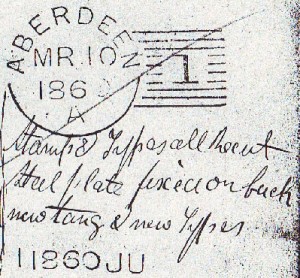 Characteristics: As Type 1 but the inner arc is missing. It is assumed that this was a recut of Type 1 (State 2) which had both ‘Es’ corrected but for some reason the inner arc was eliminated (similar to Paisley Type 2 which was Proofed on 9th May 1860). However, it has not been recorded in use.
Characteristics: As Type 1 but the inner arc is missing. It is assumed that this was a recut of Type 1 (State 2) which had both ‘Es’ corrected but for some reason the inner arc was eliminated (similar to Paisley Type 2 which was Proofed on 9th May 1860). However, it has not been recorded in use.
Proofed: 10th March 1860
EKD: ??
LKD: ??
Months of Use: ??
Known Codes: ??
Scarcity Rating: GPO (Proof Book Entry Only)
Type 4
 Characteristics: Six short bars each side of ‘1’.
Characteristics: Six short bars each side of ‘1’.
Proofed: 26th March 1860
EKD: 9th January 1861
LKD: 24th December 1862
Months of Use:

Known Codes:
![]()
During March to July 1861 a distinctive Code C was used which appears more like a sideways omega symbol – see image
Scarcity Rating: B (Common)
Picture Gallery
Type 5
 Characteristics: As Type 4 but only five short bars each side of ‘1’. In view of the LKD of Type 4 it is likely that this is a recut of Type 4 despite the Proof Book indicating it is ‘new’
Characteristics: As Type 4 but only five short bars each side of ‘1’. In view of the LKD of Type 4 it is likely that this is a recut of Type 4 despite the Proof Book indicating it is ‘new’
Proofed: 25th December 1862
EKD: 6th January 1863
LKD: 29th September 1866*
Months of Use:

*I have also seen an example which purports to be dated 7th April 1868 and has no Code. However, the year is not clear; I have included it in the Gallery for interest
Known Codes:
![]()
Scarcity Rating: B (Common)






















